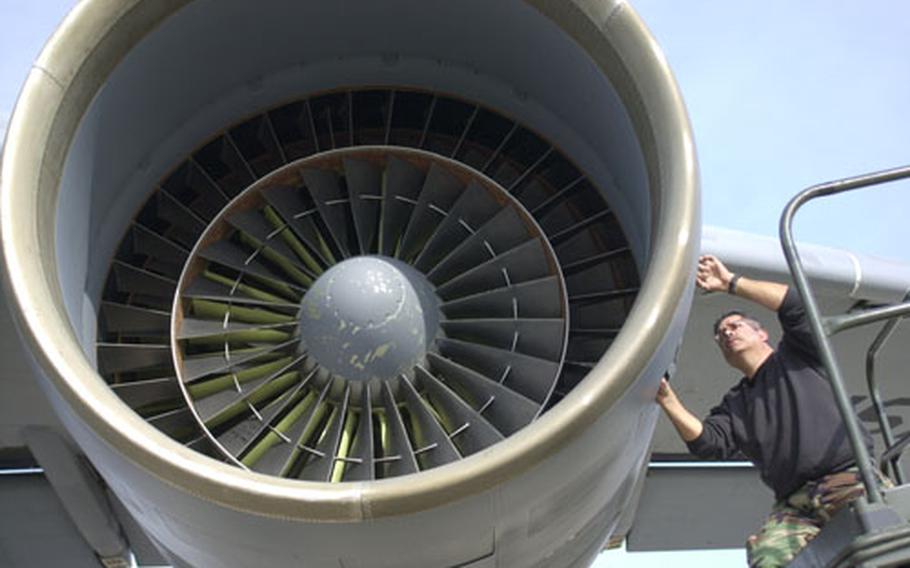
Air Force Tech Sgt. Ernest Pena works on a C-5 cargo aircraft at Morón Air Base in Spain. The base is bracing for an influx of planes and personnel due to the rotation of forces in Kuwait and Iraq in the next several months. (Scott Schonauer / Stars and Stripes)
MORÓN AIR BASE, Spain — Some people call this small base surrounded by sunflower fields the Air Force’s “Sleepy Hollow.”
But since the Sept. 11, 2001, attacks against the United States, one of the Air Force’s smallest bases has been one of its busiest.
The military has relied on the airfield as a key pit stop for cargo planes ferrying troops and cargo to the Middle East and Central Asia. During the buildup for the war in Iraq, the base set records for the number of cargo tons and passengers flown and amount of fuel pumped.
“They say we’re ‘Sleepy Hollow,’ ” said Lt. Col. Jeff Lamers, deputy commander of the 496th Air Base Squadron, the installation’s host unit. “We have not been ‘Sleepy Hollow’ for almost two years.”
Despite President Bush’s May declaration of an end to major combat operations in Iraq, the breakneck pace at Morón has not let up.
And the Air Force doesn’t expect things to slow down to pre-2001 levels any time soon.
That’s why the Air Force is sending some additional help. It is planning to station 25 to 28 more airmen in Morón by the spring to help alleviate the workload. That might not seem like a lot of people to some bases, but with about only 100 airmen permanently stationed at Morón, it is a population boom.
The base is so small that many airmen juggle four or five jobs to make things work. During the busy times, they can take on more duties.
Having more people will help airmen such as Master Sgt. Frederick Gambrel, the base’s communication maintenance manager, who also serves as a unit training manager, financial management officer, test proctor and physical training leader. An 11-hour day is typical for him.
Good time management is crucial to get everything done.
“It’s a balancing act,” Gambrel said.
Airmen stationed there said that the base has not been this busy since the first Persian Gulf War in 1991.
Since Dec. 27, 2002, when the buildup for the war in Iraq started, 3,695 aircraft passed through the base, from large C-5 cargo planes to F-117 stealth fighters. That’s more than double the number of planes in 2001.
Military cargo and transport planes have carried more than 80,000 tons of cargo and roughly 36,000 passengers. This is at a base that didn’t have a passenger terminal before the war.
Fuel specialists at Morón have pumped an astounding 74.6 million gallons of fuel. That’s more than five times as much as what Aviano Air Base in Italy pumped.
The dining facility, now open 24 hours a day, served 73,000 meals in March. That included 6,300 box lunches for passengers on the go.
“After 9/11, we went up and we stayed up,” Lamers said.
Morón is in southern Spain 35 miles southeast of Seville. In addition to the 496th’s 100 people, the base is home to a 15-person space surveillance detachment, under the direction of the Colorado-based U.S. Space Command. The base is supplemented by about 1,000 airmen sent on temporary duty.
The airfield also is an alternate emergency-landing site for the space shuttle during every launch from the Kennedy Space Center in Florida.
The base has no deployable units, but it has one of the largest ramps in Europe. The ramp is larger than either Rhein-Main or Ramstein air bases in Germany.
When the Pentagon launched Operation Enduring Freedom in Afghanistan, Morón emerged as a major stopping point for planes. During the buildup for the war in Iraq, the military sent refueling tankers to the base.
Master Sgt. Michael Baker, the airfield manager, had the daunting task of finding parking spaces for the increased number of aircrafts.
He used a computer diagram with icons representing planes to make sure there was enough room.
“During the war, that was it,” Baker said. “Finding enough real estate, making sure it all fit.”
Beginning this month, planes that ordinarily landed at Naval Station Rota on their way to the United States from Iraq will stop in Morón instead. Repair work at the Rota airfield is the reason for diverting the air traffic up north.
Morón is bracing for the additional planes by constructing more dormitories for plane crews and passengers. A small group of prefabricated units that can house 400 people will be erected within earshot of the runway.
It’s a big improvement over earlier this year, when airmen scrambling to find temporary living spaces put hundreds of cots in old warehouses and the gymnasium.
The base also is planning on boosting recreational facilities, giving a makeover to the recreation center.
The increase in aircraft comes as contractors finish a project that will include 37 new hydrant fuel pumps on the ramp. The work is scheduled to finish in January, helping planes land and refuel faster and more efficiently.
Base commanders have requested a wish list of base improvements. If troops remain in Iraq for years, chances are that the Air Force will continue to need Morón.
The 496th has a motto: Bring it on!
“We will adapt and do whatever we need to do to accomplish the mission,” Lamers said.